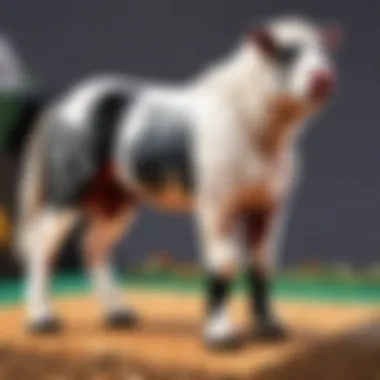Unraveling the Complexity of Animal Breeding: Insights and Perspectives


Animal breeding is a multifaceted domain that encompasses a variety of components and considerations. From the art of selective breeding to the intricate nuances of genetic diversity, the realm of animal breeding stands as a captivating intersection of science and ethics.
Understanding Selective Breeding
Selective breeding serves as a cornerstone in the realm of animal breeding. This meticulous process involves intentionally mating animals with specific desirable traits to perpetuate those characteristics in subsequent generations. By carefully choosing the breeding pairs based on desired attributes such as size, coat color, or milk production, breeders aim to enhance the quality and uniformity of the offspring.
Unraveling Genetic Diversity
Genetic diversity forms the bedrock of resilience and adaptability within animal populations. It underscores the variations present within a species, playing a critical role in ensuring their long-term survival. Maintaining genetic diversity is key to averting genetic disorders and preserving the vitality of the gene pool.
Ethical Considerations in Breeding
Ethical considerations loom large in the landscape of animal breeding. While the pursuit of specific traits can yield beneficial outcomes, breeders must navigate a fine line to ensure the well-being and health of the animals. Ethical breeding practices encompass aspects such as avoiding harmful genetic mutations, providing proper care and living conditions for the animals, and promoting overall welfare.
Impact on Biodiversity
The implications of animal breeding extend beyond individual species to impact biodiversity on a broader scale. As breeding choices shape the genetic makeup of populations, careful consideration must be given to preserving biodiversity. Balancing selective breeding practices with the conservation of diverse genetic signatures is crucial for upholding ecosystems' resilience and integrity.
Introduction
Definition of Animal Breeding
Animal breeding is the deliberate practice of mating selected individuals within a species to produce offspring with desired and profitable characteristics. It involves the manipulation of genetic material to enhance specific traits like size, productivity, temperament, or disease resistance. This controlled breeding helps in amplifying favorable genes while curbing undesirable ones, ultimately shaping the genetic composition of populations to meet human needs and preferences.
Importance of Animal Breeding


The significance of animal breeding lies in its ability to accelerate the process of trait improvement compared to natural selection. By selectively mating animals with desired traits, breeders can expeditiously enhance genetic quality, leading to higher productivity in livestock, improved companionship traits in pets, and better adaptability in research animals. Moreover, animal breeding plays a crucial role in conservation efforts by preserving genetic diversity within endangered species, thereby safeguarding their survival and biodiversity.
Overview of Animal Breeding History
The history of animal breeding dates back to the early domestication of wild animals for human use. Over centuries, humans have selectively bred animals to suit various purposes such as agriculture, transportation, and companionship. The utilization of selective breeding methods saw significant advancements during the 18th and 19th centuries with the understanding of basic genetic principles. This historical evolution paved the way for modern techniques in animal breeding, revolutionizing livestock production, pet breeding, and genetic research.
Genetics and Selective Breeding
Genetics and Selective Breeding play a pivotal role in shaping the outcomes of animal breeding practices. Understanding the genetic principles underlying breeding helps breeders make informed decisions to enhance desirable traits in offspring. Through the careful selection of parent organisms based on genetic makeup, breeders can influence characteristics such as health, productivity, and appearance in subsequent generations. The intricate dance between genetics and breeding ensures that the offspring inherit the most favorable traits, leading to improvements in overall livestock quality. Selective breeding not only amplifies beneficial genetic traits but also minimizes undesired characteristics, creating animals better suited for specific purposes or environments. This meticulous process involves strategic mating of individuals with desirable traits over multiple generations, resulting in a gradual enhancement of desired qualities within a population.
Understanding Genetic Principles
Delving into the fundamental aspects of genetic principles is vital for comprehending the mechanisms behind how traits are inherited and expressed in offspring. Genes serve as the blueprint for every living organism, carrying instructions that determine various characteristics. By grasping concepts such as dominant and recessive genes, breeders can predict the likelihood of specific traits manifesting in offspring. Factors like gene interaction and environmental influences further contribute to the intricate interplay of genetics in shaping animal traits. Understanding concepts like genetic variation, heritability, and genetic drift provides breeders with insights into the complexity of genetic inheritance and the variability observed in breeding outcomes.
Process of Selective Breeding
Selective breeding involves a meticulous process of choosing parent organisms with favorable traits to produce offspring with desired characteristics. The first step in selective breeding is identifying the desired traits that need enhancement within a population. Breeders then select parent organisms that exhibit these traits strongly, ensuring that their offspring inherit the desired qualities. Through controlled mating of selected individuals and monitoring of breeding outcomes, breeders can track the progress of trait improvement over successive generations. This iterative process requires patience, expertise, and a deep understanding of genetic inheritance patterns to achieve the desired breeding goals. By selectively breeding animals over time, breeders can create populations with heightened genetic potential and improved overall performance.
Key Factors in Selecting Breeding Stock
Selecting the right breeding stock is a critical aspect of successful animal breeding programs. Breeders must consider various factors when choosing parent organisms, including genetic diversity, health status, temperament, and conformation to breed standards. Genetic diversity plays a crucial role in preserving the resilience and adaptability of populations, reducing the risk of genetic disorders caused by inbreeding. Evaluating the health and temperament of breeding stock ensures that offspring are born healthy and exhibit desired behavioral traits. Conformation to breed standards guarantees that offspring meet the criteria set for their specific breed, maintaining breed integrity and promoting consistency in desirable traits across generations. By carefully assessing and selecting breeding stock based on these key factors, breeders can lay a solid foundation for successful breeding programs that yield quality progeny.
Breeding Techniques
Breeding techniques play a pivotal role in the realm of animal breeding, serving as the practical application of genetic principles. The efficacy of breeding techniques directly impacts the genetic diversity, health, and overall quality of animal populations. By employing various methods like artificial insemination, embryo transfer, and selective breeding, breeders can selectively enhance desired traits, improve breeding efficiency, and maintain genetic diversity within populations. Additionally, breeding techniques are vital for reducing the incidence of genetic disorders, increasing productivity, and advancing breeding programs.


Artificial Insemination
Artificial insemination stands as a crucial breeding technique that offers numerous advantages in animal breeding. This method involves the direct introduction of sperm into a female's reproductive system without natural mating. Artificial insemination allows breeders to overcome geographical limitations, select sperm from high-quality genetic donors, and increase breeding efficiency by maximizing the number of offspring from superior males. Moreover, this technique facilitates genetic diversity conservation by preserving sperm from valuable individuals and enables breeders to control the timing of insemination accurately.
Embryo Transfer
Embryo transfer revolutionizes animal breeding by enabling the transfer of embryos from genetically superior individuals to surrogate mothers. This technique facilitates the propagation of elite genetic traits, accelerates genetic gains, and allows breeders to preserve valuable genetics from individuals with limited reproductive capacity. Embryo transfer also enhances breeding efficiency by increasing the number of progeny produced per female and circumventing issues related to natural mating. Furthermore, this method permits breeders to amplify the genetic impact of outstanding individuals and streamline breeding programs effectively.
Inbreeding vs. Outbreeding
The debate between inbreeding and outbreeding in animal breeding remains a critical consideration for breeders. Inbreeding involves breeding closely related individuals and often leads to the expression of deleterious recessive alleles, causing inbreeding depression and reducing genetic diversity. On the contrary, outbreeding entails mating individuals from unrelated lineages, promoting heterosis or hybrid vigor, and enhancing fitness and performance traits. Breeders must strike a balance between inbreeding and outbreeding strategies to achieve optimal genetic improvement and health in populations while mitigating the risks of inbreeding depression and loss of beneficial alleles.
Challenges in Animal Breeding
Animal breeding poses various challenges that are crucial to address for the sustainable advancement of breeding practices. Understanding and mitigating these challenges are essential for maintaining the genetic health and diversity of animal populations. One significant aspect is the necessity of maintaining genetic diversity within breeding programs. Genetic diversity is the key to the resilience of species against diseases, environmental changes, and other unforeseen factors that may threaten their survival. Without sufficient genetic diversity, populations become more susceptible to genetic disorders and reduced vitality, jeopardizing the success of breeding programs. Addressing this challenge involves careful selection of breeding stock, implementing breeding strategies that preserve diversity, and monitoring genetic changes over generations to prevent inbreeding and genetic bottlenecks.
Maintaining Genetic Diversity
Maintaining genetic diversity is a critical aspect of animal breeding that ensures the long-term sustainability and health of populations. Genetic diversity refers to the variety of genes within a population, which is essential for adapting to new environments, resisting diseases, and promoting overall population health. In breeding programs, maintaining genetic diversity involves selecting diverse breeding stock from different lineages or populations to minimize the loss of rare or unique alleles. By incorporating genetic variation into breeding programs, breeders can enhance resilience and increase the overall fitness of offspring, ultimately contributing to the success and stability of breeding initiatives.
Inbreeding Depression
Inbreeding depression is a significant concern in animal breeding that results from breeding closely related individuals within a population. Inbreeding depression manifests as reduced health, fertility, and overall fitness of offspring due to the expression of deleterious recessive alleles. This phenomenon can lead to decreased genetic vigor, increased susceptibility to diseases, and compromised reproductive success, posing a threat to the long-term viability of breeding populations. Mitigating inbreeding depression requires implementing outbreeding strategies, such as introducing unrelated individuals into the breeding pool, conducting genetic testing to identify carriers of harmful alleles, and maintaining detailed pedigree records to track genetic relationships. By actively managing inbreeding depression, breeders can safeguard the genetic health and sustainability of breeding programs.
Ethical Considerations in Breeding Practices


Ethical considerations play a vital role in animal breeding practices, influencing decisions related to genetic manipulation, breeding goals, and animal welfare. Breeders must navigate ethical dilemmas surrounding the use of reproductive technologies, genetic modification, and selective breeding to ensure the ethical treatment of animals and the preservation of species integrity. Ethics in breeding practices encompass concerns such as animal rights, consent for genetic manipulation, transparency in breeding processes, and the impact of breeding practices on biodiversity and conservation efforts. By upholding ethical standards in breeding practices, breeders can foster public trust, promote responsible stewardship of genetic resources, and contribute to the welfare and dignity of the animals involved in breeding programs.
Impact of Breeding on Biodiversity
Animal breeding plays a pivotal role in shaping biodiversity, influencing the genetic makeup of various species. This section delves into the pivotal importance of understanding the Impact of Breeding on Biodiversity in the realm of animal breeding. Analyzing how breeding practices can either enhance or diminish biodiversity is crucial for maintaining ecological balance and species resilience. By exploring the intricate interplay between selective breeding and biodiversity conservation, we gain insights into how human intervention affects the natural order of ecosystems. The ethical implications of altering genetic diversity through breeding practices are also a central point of discussion within this section, highlighting the delicate balance required to ensure sustainable biodiversity.
Role of Animal Breeding in Conservation
In the context of conservation efforts, animal breeding emerges as a key tool for preserving endangered species and preventing species extinction. This subsection sheds light on how strategic breeding programs can help boost populations of threatened species, contributing to the overall conservation of biodiversity. Through selective breeding and controlled reproduction, conservationists can safeguard genetic diversity within vulnerable populations, mitigating the risk of genetic bottlenecks. Examining the collaborative role of zoos, wildlife reserves, and breeding centers in conservation initiatives underscores the collective effort required to protect and restore endangered species' populations.
Preserving Endangered Species
Preserving endangered species stands at the forefront of animal breeding's conservation impact, emphasizing the critical importance of genetic diversity in ensuring species survival. This segment delves into the intricate processes involved in breeding programs dedicated to safeguarding endangered species from the brink of extinction. By highlighting successful case studies and best practices in species preservation, we uncover the nuanced strategies and challenges associated with maintaining viable captive populations. The ethical considerations surrounding captive breeding, reintroduction programs, and collaborative conservation efforts underscore the multifaceted approach required to effectively preserve endangered species.
Balancing Species Preservation with Genetic Improvement
Achieving a delicate balance between species preservation and genetic improvement poses a significant challenge in animal breeding practices. This section navigates the complex terrain of balancing the need to conserve threatened species with the desire to enhance genetic traits through selective breeding. By exploring how breeding programs strive to maintain genetic diversity while simultaneously improving desirable traits within populations, we unravel the intricate dynamics at play in achieving sustainable breeding outcomes. The ethical dilemmas inherent in genetic enhancement versus species preservation underscore the necessity of informed decision-making in breeding practices aimed at both safeguarding biodiversity and promoting genetic resilience.
Future Trends in Animal Breeding
In the expansive realm of animal breeding, the exploration of future trends holds utmost significance. It serves as a compass guiding breeders towards innovative methodologies, amplifying genetic progress and livestock quality. The evolution of animal breeding not only enhances efficiency but also caters to the ever-evolving demands of diverse breeding programs. Dive deep into the future trends section to unravel the potential advancements poised to revolutionize breeding practices.
Advancements in Reproductive Technologies
Within the domain of animal breeding, advancements in reproductive technologies stand as beacons of progress, offering a plethora of tools to expand breeding horizons. From artificial insemination to IVF techniques, repro-tech not only accelerates breeding processes but also ensures the preservation of valuable genetic traits. Unveil the intricate interplay between science and reproduction, revolutionizing the way breeders accomplish their genetic objectives.
Integration of Genomics in Breeding Programs
The fusion of genomics with traditional breeding programs heralds a new era in animal husbandry, amalgamating cutting-edge scientific discoveries with age-old breeding practices. By delving into the genetic makeup of livestock, breeders gain profound insights into heritability, disease resistance, and productivity traits. Embrace the genomic revolution and witness the power of precision breeding, sculpting superior animal populations with unparalleled genetic finesse.
Sustainable Practices in Animal Breeding
In the ever-growing pursuit of sustainable agriculture, the ethos of sustainability permeates every facet of animal breeding. Sustainable practices encompass not only environmental stewardship but also social and economic viability, ensuring a holistic approach towards breeding management. Discover the essence of sustainability within breeding frameworks, balancing productivity with conservation for a harmonious coexistence with the natural world.



